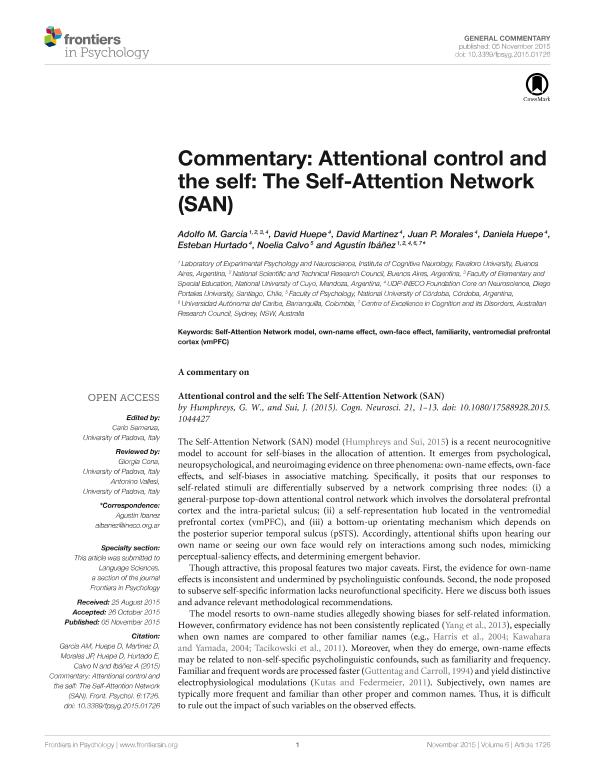Artículo
Commentary: Attentional control and the self: The Self-Attention Network (SAN)
García, Adolfo Martín ; Huepe, David; Martínez Pernía, David; Morales, Juan P.; Huepe, Daniela; Hurtado, Esteban; Calvo Garbarino, Noelia Belén
; Huepe, David; Martínez Pernía, David; Morales, Juan P.; Huepe, Daniela; Hurtado, Esteban; Calvo Garbarino, Noelia Belén ; Ibañez, Agustin Mariano
; Ibañez, Agustin Mariano
 ; Huepe, David; Martínez Pernía, David; Morales, Juan P.; Huepe, Daniela; Hurtado, Esteban; Calvo Garbarino, Noelia Belén
; Huepe, David; Martínez Pernía, David; Morales, Juan P.; Huepe, Daniela; Hurtado, Esteban; Calvo Garbarino, Noelia Belén ; Ibañez, Agustin Mariano
; Ibañez, Agustin Mariano
Fecha de publicación:
10/2015
Editorial:
Frontiers Research Foundation
Revista:
Frontiers in Psychology
ISSN:
1664-1078
Idioma:
Inglés
Tipo de recurso:
Artículo publicado
Clasificación temática:
Resumen
The Self-Attention Network (SAN) model (Humphreys & Sui, 2015) is a recent neurocognitive model to account for self-biases in the allocation of attention. It emerges from psychological, neuropsychological, and neuroimaging evidence on three phenomena: own-name effects, own-face effects, and self-biases in associative matching. Specifically, it posits that our responses to self-related stimuli are differentially subserved by a network comprising three nodes: (i) a general-purpose top-down attentional control network which involves the dorsolateral prefrontal cortex and the intra-parietal sulcus; (ii) a self-representation hub located in the ventromedial prefrontal cortex (vmPFC), and (iii) a bottom-up orientating mechanism which depends on the posterior superior temporal sulcus (pSTS). Accordingly, attentional shifts upon hearing our own name or seeing our own face would rely on interactions among such nodes, mimicking perceptual-saliency effects and determining emergent behavior.Though attractive, this proposal features two major caveats. First, the evidence for own-name effects is inconsistent and undermined by psycholinguistic confounds. Second, the node proposed to subserve self-specific information lacks neurofunctional specificity. Here we discuss both issues and advance relevant methodological recommendations.
Archivos asociados
Licencia
Identificadores
Colecciones
Articulos(SEDE CENTRAL)
Articulos de SEDE CENTRAL
Articulos de SEDE CENTRAL
Citación
García, Adolfo Martín; Huepe, David; Martínez Pernía, David; Morales, Juan P.; Huepe, Daniela; et al.; Commentary: Attentional control and the self: The Self-Attention Network (SAN); Frontiers Research Foundation; Frontiers in Psychology; 6; 10-2015; 1726-1726
Compartir
Altmétricas



